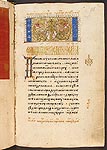Tetraevangelion.
First half of 16th cent. One of artists: Feodosy, son of Dionysius
F (280 ı 185). I+335 leaves.
Paper. Ink, cinnabar, colours, gold.
It is written in a semi-uncial hand.
The decoration of the manuscript includes head-pieces and initials in colourÏË and gold (fols. 8r, 248r, 318r), head-pieces in the Fryazhsky (Noth Italian) style (fols. 101r, 248r, 318r). Glued-on head-pieces are copper-plate engravings, painted in colours (fols. 101r and 155r). The text on folio 8r is surrounded by a frame with a floral design, painted in colours and gold.
This Gospel is an excellent example of the book arts of medieval Russia dating from the first half of the 16th century. The manuscript reflects new tendencies in decoration of manuscript books, in particular, use of copper-plate engravings as head-pieces. An engraved head-pieces on folio 155r bears Feodosy's autograph signature: "The icon-painter Feodosy". Researchers suppose that this engraving was produced after drawing of Feodosy, the son of Dionysius, a famous icon-painter from the late 15th century. The Tetraevangelion contains the ownership mark of Yefim Tsypletev, a prominent Moscow state figure from the 16th century. His family made repeatedly rich donations to the Kirillo-Belozersky Monastery.
In 1918 the manuscript came into the State Public Library along with the other materials from the library of the Kirillo-Belozersky Monastery.
Shelfmark: –Õ¡. Ë.-¡ÂÎ. 37/42.





